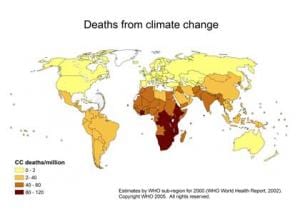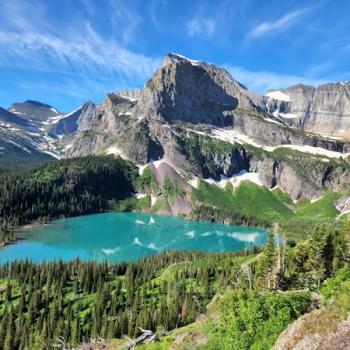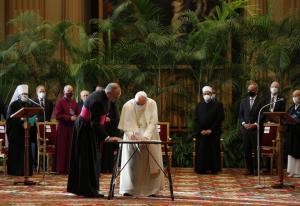Trump begins withdrawal from Paris Climate Agreement
 On June 1, 2017, Donald Trump announced that he would pull the United States out of the Paris Climate Agreement at the earliest possible date. The earliest possible date to begin the process was November 4, 2019. On that date, through Secretary of State Pompeo, Trump announced the formal beginning of the process. In fulfillment of a campaign promise, Trump threatens to commit the world’s most anti-life deed. If completed it will result in more lives lost than any other single deed that I can think of.
On June 1, 2017, Donald Trump announced that he would pull the United States out of the Paris Climate Agreement at the earliest possible date. The earliest possible date to begin the process was November 4, 2019. On that date, through Secretary of State Pompeo, Trump announced the formal beginning of the process. In fulfillment of a campaign promise, Trump threatens to commit the world’s most anti-life deed. If completed it will result in more lives lost than any other single deed that I can think of.
Backing out of the Paris Climate Agreement is an attack on the young and the unborn. They are the ones who will suffer most in the decades to come as the earth continues to warm with catastrophic consequences. Storms and droughts will grow more intense. Coastal cities will flood more often. Glaciers, crucial sources of water for a billion of the world’s people, will disappear. We are already seeing climate refugees. Their number will far exceed the number of today’s refugees from wars.
Catholic response
A National Catholic Reporter article lists several Catholic organizations condemning Trump’s move. They include the Leadership Conference of Women Religious, Catholic Relief Services, the Maryknoll Office for Global Concerns, the Columban Center for Advocacy and Outreach, the Sisters of Mercy of the Americas, the Franciscan Action Network. “This will have disastrous consequences for life on our planet as we know it,” the Franciscan Network’s executive director said of this “selfish, partisan maneuver.”
Popes Saint John Paul II, Benedict XVI, and Francis have spoken clearly and in unity about the moral and hazard of climate change and its destructive effects, especially on the poor. And they are the ones least responsible.
On the opposite end of the responsibility spectrum stands the United States. Some people that I have talked to hide behind China, the new leader in greenhouse gas emissions. We’re not as bad as China. Let them clean up first. Well, in what counts most we are as bad as china, or worse. Our per capita emissions are still much worse than China’s. Besides that, China’s carbon footprint is unfairly enlarged by all the products that we buy from China. We’re outsourcing part of what should count as our greenhouse gas emissions.
The lungs of the planet
The Synod on the Amazon spoke clearly about the ways developed countries’ are harming the Amazon rainforest. First, they cause global warming, which negatively impacts many forest species. Our habits of consumption demand meat from clear-cut forest land and metals and other minerals mined, despite environmental harm, from the Amazon.
The Synod repeats the common metaphor “lungs of the planet” to describe the rainforest. It’s an odd way of describing the benefit that the Amazon supposedly gives to the world. All the lungs I know of breathe in good air and breathe out bad air. The metaphor is ironically appropriate, though. As the amazon burns, it “breathes out” the carbon that over centuries it breathed in. Only a growing Amazon breathes out an excess of oxygen.
“Untold suffering” from climate emergency
Recently 11,000 scientists from around the world declared “clearly and unequivocally that planet Earth is facing a climate emergency.” Forty years since the First World Climate conference, greenhouse gas emissions are still rising. Earth is heating faster than anticipated with damaging results more severe than previously thought.“The climate crisis has arrived and is accelerating faster than most scientists expected.” Efforts to cut greenhouse gas emissions and conserve the biosphere must increase dramatically “to avoid untold suffering due to the climate crisis.”
The scientists link the crisis closely to a wealthy lifestyle of excessive consumption.” Consumption of energy from all sources has risen dramatically. Percentage-wise solar and wind rose the most; but, starting near zero, that doesn’t amount to nearly enough. Specific contributors to rising energy use include:
- Meat consumption, up 50%
- Air transport, up nearly 700%
- Total human population, nearly doubled
Meanwhile, fossil fuel subsidies, which started going down a few years ago, have been rising the last two years.
The scientists report on visible and measurable changes in the natural environment:
- Average surface temperature, up nearly 1 degree Celsius over pre-industrial time
- Arctic sea ice, annual minimums down about 3 million square kilometers
- Greenland and Antarctic ice mass, currently falling at combined rate of 3840 gigatons per 10 years
- Ocean heat and acidity both rising, sea level rising
- Acres burned per year by wildfires, tripled since early 1980’s
- Extreme weather events per year, almost quadrupled since 1980
- Annual losses due to weather, over six-fold increase since 1980
All of these foreseeable developments will be worse with Trump’s backing away from the task of reimagining and correcting our wasteful, polluting, life-destroying use of the world’s resources.
Local consequences
The world is a big place, and for most people their local area is much more real. My local area is Minnesota, so I went to a talk on global warming by Minnesota Public Radio meteorologist Paul Huttner. There I got much of the local story. I’ve added details from the Minnesota Pollution Control Agency website:
- Minnesota, on average, will warm 5 degrees Fahrenheit in the next century.
- In the last 10 years we’ve had three “thousand year” storms, storms that, except for global warming, should occur once in a thousand years.
- In 60 years total precipitation increased over 20 percent. We’ve seen the results: crop, home, and business damage and rising insurance rates for all three. Rainfall is expected to happen less frequently but with much greater intensity.
- Lake Superior is 3.6 inches higher than the long-term average.
- Warming lake and river waters combined with algal blooms from increased erosion are leading to significant loss of fish habitat.
Lives being lost
It’s not just a question of comfort and quality of life. Global warming makes weather patterns unpredictable and food and water supplies less secure. Malnutrition increases. Mosquitoes and other pests thrive in hot, humid weather, so diseases like malaria and dengue fever will rise. More floods will contaminate more sources of drinking water. Global warming speeds the spread of infectious diseases. Heat waves and weather-related disasters are increasing.
Scientists from the World Health Organization and the University of Wisconsin-Madison researched the number of deaths and illness that due to global warming. Each year global warming causes 150,000 additional deaths and 5 million human illnesses around the world. They fear that number “may well double by 2030 even if we start getting serious about emissions reductions today.”
But couldn’t milder winters on a warming planet result in fewer deaths? Harvard researchers studied deaths resulting from two-day cold snaps and similar periods of extremely hot weather in 50 American cities. They found a 1.59 percent increase in deaths during cold snaps and a 5.74 percent increase during the hot periods.
These death and illness figures don’t take into account plain old pollution from burning fossil fuels. Putting a number on deaths from pollution is harder than, say, from car accidents. Air pollution basically speeds up mortality, especially for certain groups of people.
The London Guardian describes how the scientists translated that into more comprehensible death figures. Air pollution kills seven million people who wouldn’t have died that year. Or,
there are 120 extra deaths per every 100,000 people per year. Put that way, it might not sound too bad. But we don’t regard, say, the three people murdered in Europe per 100,000 per year as remotely acceptable.
A pro-life economy
Of course, we all die eventually. These millions of deaths represent an average loss of two years of life for everyone on the planet. That also is part of the global warming story. Lives will be saved and quality of life will be improved if we move from our current reliance on fossil fuels to an economy based on carbon-free energy sources.
Being pro-life means much more than opposing abortion. For the United States it means staying with worldwide efforts, including the Paris Climate Agreement, to reduce global warming emissions. It could mean following New Zealand’s example. Recently they joined other countries, cities and states, in pledging to cut emissions to zero by 2050. It means regaining the moral status our country had when the Obama administration contributed to the working out of the Paris accord. It means following through on the commitment rich countries made to help poor countries both adapt to climate change and move their economies in a sustainable direction as they improve their people’s lives.
Image credit: World Health Organization via Google Images












